
Uthavedeeswarar Temple is a Hindu temple in the town of Kuthalam in the Mayiladuthurai district of Tamil Nadu, India. The temple is dedicated to Shiva.

Uthavedeeswarar Temple is a Hindu temple in the town of Kuthalam in the Mayiladuthurai district of Tamil Nadu, India. The temple is dedicated to Shiva.
Shiva as Uthavedeeswarar is the presiding deity. According to Hindu mythology, Shiva was married to Parvathi at this place and the god is believed to have left his sandals here before embarking for Mount Kailash. The Saivite saint Sambandar has composed hymns in praise of the temple in Thevaram . Several sages like Kashyapa, Angirasa, Gotama, Markandeya, Vashista, Kulastya and Agastya. The temple is counted as one of the temples built on the banks of River Kaveri. It is believed that the river was flowing on both sides of the village. [1]
Uthavedeewarar is to estimate 1000 - 2000 years ago.
Uddhala tree is famous in this temple. It is found only here in this entire world.

Mahamaham, also known as Mahamagham or Mamangam, is a Hindu festival celebrated every 12 years in the Mahamaham tank located in the city of Kumbakonam in Tamil Nadu in the south of India. This 20-acre square tank surrounded by Shiva mandapams is believed by Tamil Hindus to be ancient, and the holy confluence of nine Indian river goddesses: Ganga, Yamuna, Sarasvati, Narmada, Godavari, Krishna, Tungabhadra, Kaveri, and Sarayu, states Diana Eck – a professor of Comparative Religion and Indian Studies. On the day of the Mahamaham festival, the river goddesses and Shiva gather here to rejuvenate their waters, according to a legend in the Periya Purana. The Hindus consider taking a pilgrimage and holy dip at the Mahamaham tirtha on the day of Mahamaham festival as sacred. The event attracts chariot processions, street fairs and classical dance performances in temple mandapas. The 12-year cycle Mahamaham festival in Tamil Nadu is observed in the Hindu calendar month of Magha, and is a symbolic equivalent of the Kumbh Mela.
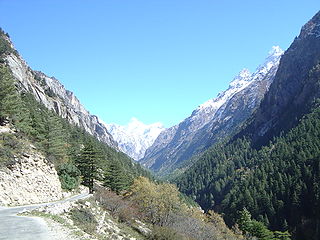
Gangotri is a town and a Nagar Panchayat (municipality) in Uttarkashi district in the state of Uttarakhand, India. It is 99 km from Uttarkashi, the main district headquarter. It is a Hindu pilgrim town on the banks of the river Bhagirathi – the origin of the river Ganges. The town is located on the Greater Himalayan Range, at a height of 3,100 metres (10,200 ft). According to a popular Hindu legend, the goddess Ganga descended here when Shiva released the mighty river from the locks of his hair.

The Shri Trimbakeshwar Shiva Temple is an ancient Hindu temple in the town of Trimbak, in the Trimbakeshwar tehsil in the Nashik District of Maharashtra, India, 28 km from the city of Nashik and 40 km from Nashik road. It is dedicated to the Hindu god Shiva and is one of the twelve jyotirlingas where the Hindu genealogy registers at Trimbakeshwar, Maharashtra are kept. The origin of the sacred Godavari river is near Trimbak.
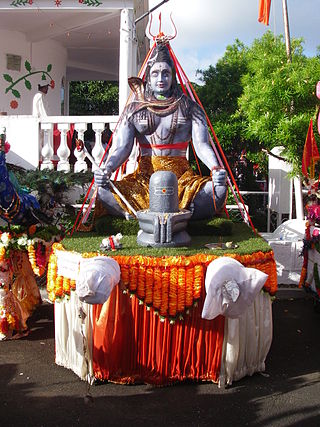
Maha Shivaratri is a Hindu festival celebrated annually in honour of the deity Shiva, between February and March. According to the Hindu calendar, the festival is observed on the fourteenth day of the first half of the lunar month of Phalguna. The festival commemorates the wedding of Shiva and Parvati, and the occasion that Shiva performs his divine dance, called the Tandava.

Uthamar Kovil in Uthamarkoil, a village in the outskirts of Tiruchirappalli in the South Indian state of Tamil Nadu, is dedicated to the Hindu Trimurti of Vishnu, Shiva, and Brahma. Constructed in the Dravidian style of architecture, the temple is glorified in the Nalayira Divya Prabandham, the early medieval Tamil canon of the Alvar saints from the 6th–9th centuries CE. It is one of the 108 Divya Desams dedicated to Vishnu, who is worshipped as Purushothaman Perumal and his consort Lakshmi as Poornavalli Thayar.

Omkareshwar is a Hindu temple dedicated to Shiva, located in Mandhata, nearby Khandwa city in Khandwa district of the Indian state of Madhya Pradesh. It is one of the 12 revered Jyotirlinga shrines of Shiva. It is on an island called Mandhata, near Khandwa city in the Narmada river at Khandwa district in Madhya Pradesh, India; the shape of the island is said to be like the Devanagari ॐ symbol.
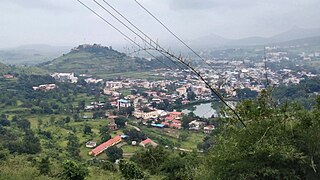
Trimbak is a city and a municipal council in Nashik District in the Indian state of Maharashtra. The Trimbakeshwar Shiva Temple is located here, one of the twelve Jyotirlingas, where the Hindu genealogy registers at Trimbakeshwar, Maharashtra are kept. The origin of the sacred Godavari river is near Trimbak.
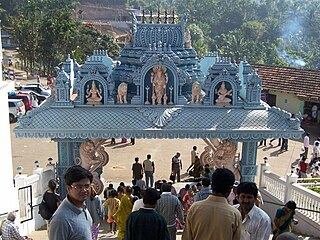
The Annapoorneshwari Temple is a Hindu temple dedicated to the goddess Annapoorneshwari (Annapoorna), located at Horanadu, Karnataka, India, 100 km from Chikmagalur in the thick forests and valleys of the Western Ghats of Karnataka. It is situated on the banks of river Bhadra.
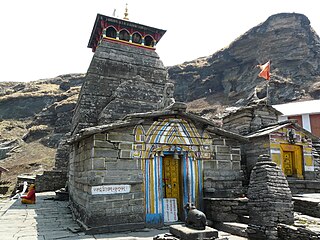
Tungnath (IAST:tuņgnāth) is one of the highest Shiva temples in the world and is the highest of the five Panch Kedar temples located in the Rudraprayag district, in the Indian state of Uttarakhand. The Tungnath mountains form the Mandakini and Alaknanda river valleys. It is located at an altitude of 3,690 m (12,106 ft), and just below the peak of Chandrashila. It has a rich legend linked to the Pandavas, heroes of the Mahabharata epic.

Hara Saabha Vimochana Perumal Temple in Thirukandiyur, a village in the outskirts of Thiruvayaru in the South Indian state of Tamil Nadu, is dedicated to the Hindu god Vishnu. Constructed in the Dravidian style of architecture, the temple is glorified in the Nalayira Divya Prabandham, the early medieval Tamil canon of the Alvar saints from the 6th–9th centuries CE. It is one of the 108 Divya Desam dedicated to Vishnu, who is worshipped as Hara Saabha Vimochana Perumal and his consort Lakshmi as Kamalavalli Nachiyar.

Swetharanyeswarar Temple is a Hindu temple dedicated to the deity Shiva, located in Thiruvenkadu, a village in Mayiladuthurai district in the South Indian state of Tamil Nadu. Shiva is worshiped as Swetharanyeswarar, and is represented by the lingam. His consort Parvati is depicted as Brahmavidyambigai. The presiding deity is revered in the 7th-century-CE Tamil Saiva canonical work, the Tevaram, written by Tamil saint poets known as the Nayanars and classified as Paadal Petra Sthalam. It is significant to the Hindu sect of Saivism as one of the temples associated with the nine planet elements, the Navagraha Stalas, and specifically Budha.

Edaganathar Temple is a Hindu temple dedicated to the deity Shiva, located in Thiruvedagam, a village in Madurai district in the South Indian state of Tamil Nadu. The temple is located on the banks of Vaigai River. Shiva is worshipped as Edaganathar, and is represented by the lingam. His consort Parvati is depicted as Visalakshi. The presiding deity is revered in the 7th century Tamil Saiva canonical work, the Tevaram, written by Tamil saint poets known as the nayanars and classified as Paadal Petra Sthalam.
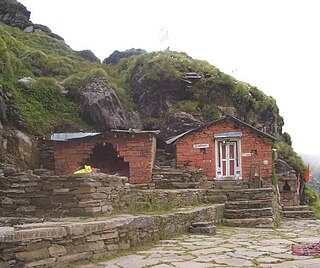
Rudranath is a Hindu temple dedicated to God Shiva, located in the Garhwal Himalayan mountains in Uttarakhand, India. Located at 3,600 metres (11,800 ft) above sea level, this natural rock temple is situated within a dense forest of rhododendron dwarfs and Alpine pastures. The temple is the second temple to be visited in the Panch Kedar pilgrimage circuit, comprising five Shiva temples in the Garhwal region to be visited in a strict pecking order starting with Kedarnath at an altitude of 3,583 m, the Tungnath (तुंगनाथ)(3,680 m or 12,070 ft), Rudranath (रुद्रनाथ), Madhyamaheshwar (मध्यमहेश्वर) and Kalpeshwar (कल्पेश्वर).

Panch Prayag is an expression in Hindu religious ethos, specifically used to connote the five sacred river confluences in the Garhwal Himalayas in the state of Uttarakhand, India. The five prayags - prayaga meaning "place of confluence of rivers" in Sanskrit - also termed as "Prayag pentad" are Vishnuprayag, Nandaprayag, Karnaprayag, Rudraprayag and Devprayag, in the descending flow sequence of their occurrence.

Sri Bhramaramba Mallikarjuna Temple or Srisailam Temple is a Hindu temple dedicated to the deities Shiva and Parvati, located at Srisailam in the Indian state of Andhra Pradesh.
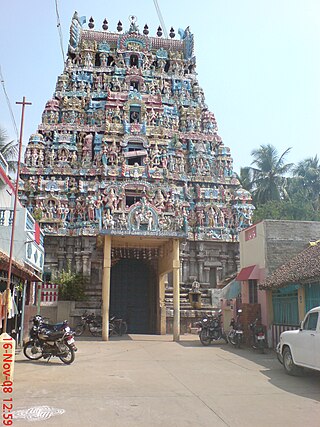
Kasi Viswanathar Temple, Kumbakonam is a Hindu temple dedicated to Lord Shiva, located in Kumbakonam, Tamil Nadu, India. Here, Lord Shiva is worshipped as Kasi Viswanathar, and His consort Parvati is depicted as Visalakshi. The presiding deity is revered in the 7th-century Tamil Saiva canonical work, the Tevaram, written by Tamil saint poets known as the nayanars and classified as Paadal Petra Sthalam.
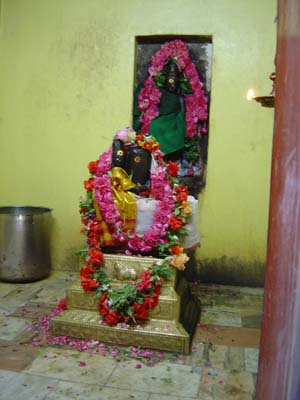
Sakthivanesvara Temple is a temple dedicated to the Hindu god Shiva located in a small village called Thirusakthimutram, near another small village, Patteswaram. The nearest urban centre, about seven kilometres away, is Kumbakonam in the Indian state of Tamil Nadu. Here the presiding deity Sakthivanesvara is a form of the Hindu god Shiva, in which his usual worship symbol the Lingam is hugged by his consort Parvati, hence he is also known as Sivakozhundeesvara and Sakthi Mutham. It is believed that when one prays to Sakthivanesvara with faith, one is blessed with the life partner of one's choice.

The Agniswarar Temple is a Hindu temple in the village of Kanjanur, 18 kilometres north-east of Kumbakonam. The presiding deity is Sukra (Venus). However, the main idol in the temple is that of "Agniswarar" or Shiva. In concordance with the Saivite belief that Shiva is all-pervading, Sukra is believed to be located within the stomach of the idol of Shiva.
Uttarakhand is a state in the northern part of India. It is often referred to as the "Devbhumi" due to its religious significance and numerous Hindu temples and pilgrimage sites found throughout the state. As a result, religious tourism forms a major portion of the tourism in the state. Uttarakhand is known for the natural environment of the Himalayas. 2019 Tourist Arrivals Domestic – 40,000,000 per/year and Foreigner – 150,000 per year. Tourism business in Uttarakhand generated ₹ 23,000 crores during 2013–14.